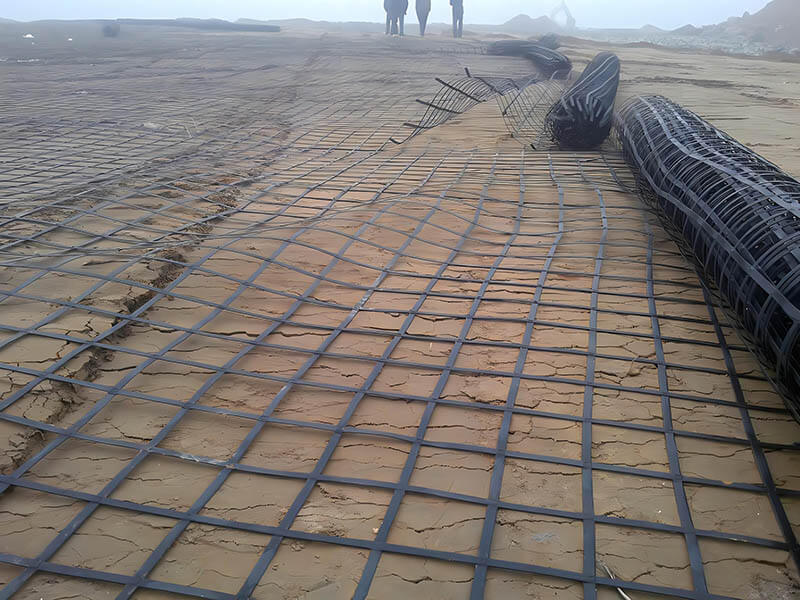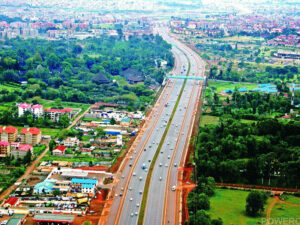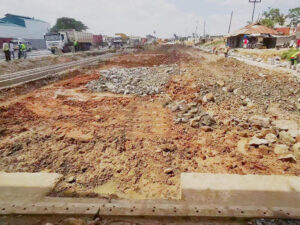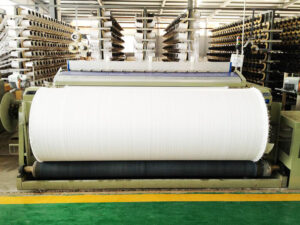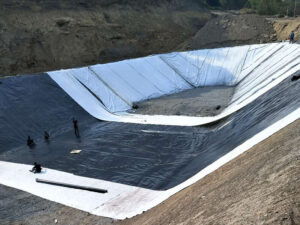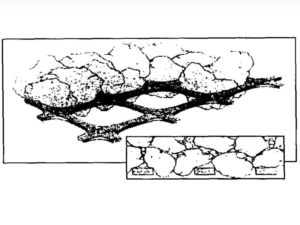In the realm of civil engineering and soil stabilization, few materials hold as much significance as geogrids. it offers a myriad of benefits that range from reinforcing soil structures to enhancing load-bearing capacities. In this comprehensive guide, we delve into the multifaceted world of geogrids, exploring their definition, classification, applications, installation techniques, and purchasing considerations.
Now, let us unravel the fabric of geogrids and uncover their indispensable role in soil stabilization.
Table of Contents
What is Geogrid?
Geogrid, or geogrid fabric, is a two-dimensional grid or a three-dimensional grid screen with a certain height made of polymer materials. It is made of materials such as high-strength, low-elongation polymers, fiberglass, steel, polypropylene, polyvinyl chloride and other polymers. It has the characteristics of high impact strength, corrosion resistance and anti-aging. Used in civil engineering and land improvement. The main purpose of geogrid is to prevent soil erosion, improve soil mechanical properties, enhance the tensile strength and shear strength of the soil, increase the internal friction of the soil, and improve the stability and load-bearing capacity of the soil so that it can withstand larger loads.
In the construction field, geogrid is widely used as a geographical grid material. It looks like a fishing net, but it has higher strength, stiffness and durability in both horizontal and vertical lines than a fishing net. Therefore, geogrids have a very long life. As a very practical and durable material, geogrids can still have a service life of several decades to 120 years, depending on the use environment and manufacturing materials.
What are Geogrids Used For?
Geogrids are commonly used in the fields of road construction and civil engineering. Here we will list its detailed applications in these two fields.
1. Water Conservancy Construction
In water conservancy projects, geogrids can be used to reinforce river beds, prevent soil erosion, protect dams and reservoirs, and manage water environments. Effectively improve flood control and water resource utilization efficiency.
2. Environmental Engineering
In urban environmental management and construction, geogrids can be used for road reconstruction, water system improvement, park greening, land backfilling, etc.
3. Mining Engineering
In mining engineering, geogrids can be used to reinforce and control the stability of the soil at the mining site, reduce soil deformation and impact, and improve mining efficiency.
4. Slope Protection Project
Geogrids can also be used for slope protection. Because of its good flexibility and water permeability, it can effectively withstand the impact of a large amount of water flow, disperse and guide the water flow, and increase the water flow area, residence time and diffusion distance, thereby preventing soil loss and protecting the stability of the slope.
5. Roadbed Project
Geogrids can effectively improve the load-bearing capacity and stability of the roadbed and prevent settlement and cracking of the roadbed.
6. Dike Engineering
Geogrids can enhance the integrity and stability of the soil and improve the flood control capacity of the dam.
7. Tunnel Engineering
Geogrid can improve the tunnel’s impermeability and structural stability, and improve the tunnel’s durability.
8. Bridge Engineering
Geogrids can enhance the stability of bridge abutments and piers, improving the safety and service life of bridges.
9. Highway Engineering
Geogrids can strengthen the pavement structure, improve the load-bearing capacity and stability of the pavement, and extend the service life of the pavement.
10. Railway Engineering
Geogrids can strengthen railway subgrade and track structures and improve railway safety and stability.
11. Construction Projects
Geogrids can strengthen foundations and basements, improving the load-bearing capacity and stability of buildings.
12. Other Functions
In addition to the above functions, geogrids can also be used in other fields such as municipal facilities and ecological engineering, playing an important supporting and auxiliary role.
Why Use Geogrid?
It is cheap, strengthens the soil structure, and enhances the soil’s bearing capacity. These advantages make geogrids a must-have material in the field of geotechnical engineering. In addition, it has many other unparalleled advantages and features. That’s why geogrids are such a cost-effective material.
1. Strengthen and Solidify the Soil
In the construction of roads, railways, airports, docks, etc., due to the complex soil structure of the roadbed layer, the load-bearing capacity of the roads is low. The special structure of geogrid can effectively strengthen and solidify the soil in the roadbed layer. With reasonable design and construction, geogrids can improve the load-bearing capacity of the road and extend the service life of the road.
2. Prevent Soil Erosion, Sliding and Erosion
In highway, water conservancy, coastal protection and other projects, soil erosion, sliding and scouring problems often occur. Geogrids are also very effective in preventing soil erosion. In terms of water and soil loss and slope erosion, geogrids can effectively control the flow rate and distribution of water flow. At the same time, through its pore structure, water flow can penetrate into the groundwater layer, thereby achieving the effect of maintaining soil moisture.
3. Reinforce Underground Structures
Geogrids can also be used for reinforcement and construction in underground projects. In tunnel excavation, subway construction, coal mining and other projects, due to weak soil and high groundwater levels, it is easy to cause ground collapse and groundwater inflow. The use of geogrids can increase the stability of the soil and prevent ground collapse and groundwater influx, thereby ensuring the smooth progress of the project.
4. Protect the Environment
In the fields of ecological environment construction and ecological restoration, geogrids can be used to build protective forest belts, slope protection greening, and ecological environment restoration projects. The use of geogrids can effectively prevent soil erosion and environmental damage, protect the ecological environment, and provide a better environment for human habitation.
5. Reinforce the Soil
Geogrids are often used to reinforce soil and improve soil mechanical properties. It mainly forms a spatial structure similar to beams and plates in the soil, effectively improving the structure and strength of the soil, and thereby increasing the bearing capacity of the foundation. Under vertical load, horizontal load, or dynamic load, it can effectively resist soil deformation and limit slip, settlement and collapse in the soil.
6. Filter Water Quality
Geogrids can also be used for sewage treatment and water resources protection. Its pore structure can prevent large particles and suspended matter from entering the underlying soil layer or water source, achieving the effect of filtering water quality. At the same time, geogrids also have good applications in river bed protection and other aspects.
7. Slope Stability
Slope stabilization is another important application area of geogrids. Through the correct use of geogrids, we can maintain the stability of slopes, prevent and manage slope erosion, landslides and other disasters, and achieve the goals of ecological restoration, land conservation and biological conservation.
8. Resistant to Wind and Wave Erosion
Geogrids can also be used to resist wind and wave erosion. In coastline protection, using geogrid as a slope protection structure, it can effectively prevent wave and storm surge erosion and achieve coastline stability and protection.
Is Geogrid Necessary?
In the field of civil engineering, geogrids are not a mandatory material. It has many alternatives, such as steel mesh, geotechnical nail wall, geotechnical grid, etc. But it is one of the most cost-effective geotechnical materials. It includes the following unparalleled advantages.
1. Improve the Stability of Project Construction
Geogrids can significantly improve stability in engineering construction. By laying geogrids, the integrity and stability of soil, sand gravel and other materials can be effectively enhanced to prevent soil erosion and slippage, thus improving the reliability of project construction. Especially in areas with complex geological conditions, the use of geogrids can significantly improve the stability and safety of the project.
2. Reduce Construction Period and Save Costs
The application of geogrids can also effectively reduce construction time and save costs. Because geogrids have strong tensile strength and durability, they can extend the service life of the project, thereby reducing the number of repairs and reconstructions and reducing project maintenance costs. At the same time, the use of geogrids can also simplify the construction process, improve construction efficiency, and further shorten the construction period.
3. Improve the Quality of Project Construction
The application of geogrids can also improve the quality of engineering construction. By enhancing the structural properties of soil, sand gravel and other materials, geogrids can effectively improve the load-bearing capacity and durability of the project, and reduce problems such as deformation, cracking, and damage of the project, thereby improving the construction quality and service life of the project.
What are the Types of Geogrid?
Geogrids are divided into plastic, fiber, polyester, steel-plastic, and other types according to the manufacturing materials. It can also be divided into one-way and two-way grilles according to their shapes. Here is a detailed introduction to each type.
Plastic Geogrid
The plastic geogrid is stretched to form a square or rectangular polymer mesh, which can be either unidirectional or bidirectional depending on the stretching direction during manufacture. It punches holes in extruded polymer sheets (the raw materials are mostly polypropylene or density polyethylene), and then performs directional stretching under heating conditions. One-way stretch grating is only made by stretching the plate along the length direction; two-way stretch grating is made by continuing to stretch the one-way stretched grating in the direction perpendicular to its length.
Since the polymer molecules of the plastic geogrid will be rearranged during the heating and elongation process during the manufacturing process, the bonding force between the molecular chains will be strengthened to achieve the purpose of increasing its strength. Its elongation is only 10 to 15 times that of the original plate. If materials such as carbon black are added to the geogrid, it can have better acid, alkali, and isochronic properties.
The role of plastic geogrid
- Increase the load-bearing capacity of the roadbed or foundation and extend the utilization time of the roadbed or foundation.
- Prevent pavement or ground from collapsing or cracking, and keep the ground beautiful and tidy.
- Convenient construction, saving time and effort, shortening time and reducing maintenance costs.
- Reduce the thickness of the cushion and save costs.
- It can effectively block the transmission of seismic force and has an important effect on strengthening the seismic rigidity, strength and stability of the embankment.
One-way plastic geogrid
Uniaxially stretched geogrid is a type of geogrid that uses molecular polymers as the main raw material and adds some additives. After uniaxial stretching, the originally scattered chain molecules are reoriented and arranged into a linear state. It is a high-quality geotechnical material that is extruded into a thin plate, punched into a regular mesh, and then stretched longitudinally.
The role of One-way plastic geogrid
- Reinforce the roadbed, which can effectively distribute the diffuse load, improve the stability and bearing capacity of the roadbed, and extend the service life. Can withstand greater alternating loads.
- Prevent roadbed deformation and cracking caused by loss of roadbed material. Improve the self-supporting capacity of the filling behind the retaining wall, reduce the earth pressure of the retaining wall, save costs, extend the service life, and reduce maintenance costs.
- Combined with the shotcrete construction method for slope maintenance, it can not only save 30%-50% of investment but also shorten the construction period by more than double.
- Adding geogrids to the roadbed and surface layer of the highway can reduce deflection, reduce rutting, delay the appearance of cracks by 3-9 times, and reduce the thickness of the structural layer by up to 36%. Applicable to all kinds of soil, no need to source materials from other places, saving labor and time.
It is widely used in dams, tunnels, docks, highways, railways, construction and other fields.
Two-way plastic geogrid
Biaxially stretched plastic geogrid is made of molecular polymer through extrusion, plate forming and punching processes and then stretched longitudinally and transversely. The material has great tensile strength both longitudinally and transversely. This structure can also provide an ideal interlocking system for greater force bearing and diffusion in the soil, and is suitable for large-area load-bearing foundation reinforcement.
Two-way plastic geogrid function
- Increase the bearing capacity of the road (foundation) foundation and extend the service life of the road (foundation) foundation.
- Prevent the road (ground) surface from collapsing or cracking, and keep the ground beautiful and tidy.
- Convenient construction, saving time and effort, shortening the construction period and reducing maintenance costs.
- Prevent cracks in the culvert.
- Strengthen soil slopes to prevent soil erosion.
- Reduce the thickness of the cushion layer and save costs.
- Support the stable greening environment of slope grass planting mesh mat.
- It can replace metal mesh and be used for false roof mesh in coal mines.
Fiberglass geogrid
Fiberglass geogrid is a mesh structure material made of glass fiber using a certain weaving process. To protect the glass fiber and improve its overall performance, it is a geocomposite material that has undergone a special coating process. Glass fiber is mainly composed of silicon oxide and is an inorganic material. Its physical and chemical properties are extremely stable, and it has high strength, high modulus, high wear resistance and excellent cold resistance, no long-term creep, and thermal stability. good. Because the surface is coated with special modified asphalt, it has dual composite properties, which greatly improve the wear resistance and shearing capacity of the geogrid.
Fiberglass geogrid function
- It has high strength, small creep, adapts to various environmental soils, and can fully meet the use of tall retaining walls in high-grade highways.
- It can effectively improve the interlocking and interlocking effect of the reinforced bearing surface, greatly enhance the bearing capacity of the foundation, effectively restrain the lateral displacement of the soil, and enhance the stability of the foundation.
- Compared with traditional gratings, it has the characteristics of high strength, strong load-bearing capacity, corrosion resistance, anti-aging, large friction coefficient, uniform holes, convenient construction, and long service life.
- More suitable for deep-sea operations and bank reinforcement, it fundamentally solves the technical problems of low strength, poor corrosion resistance, and short service life caused by gabions made of other materials due to long-term erosion by seawater.
- It can effectively avoid construction damage caused by being crushed and damaged by machinery during the construction process.
Warp knitted polyester geogrid
Warp-knitted polyester geogrid, also known as high-strength polyester filament warp-knitted geogrid, polyester fiber geogrid, polyester warp-knitted geogrid, is made of industrial high-strength, high-modulus, low-shrinkage twisted polyester filaments. become. This kind of geogrid uses high-performance warp knitting equipment to directionally weave grid fabrics, and the intersection points are bundled with high-strength fiber filaments to form a strong bonding point. It is then coated with polyvinyl chloride (PVC) or styrene-butadiene latex and other additives to form a flat mesh material. This increases its strength, shear force, and various indicators, giving full play to its mechanical properties.
Warp knitted polyester geogrid functions:
- It has tensile strength, small elongation force, high tear resistance strength, and small difference in longitudinal and transverse strength;
- Resistant to ultraviolet aging, abrasion resistance, corrosion resistance, lightweight, strong interlocking ability with soil or gravel, and plays a significant role in enhancing the shear resistance of soil and reinforcing and improving the integrity and load capacity of soil.
Mine Geogrid
Mining geogrid is a plastic protective net used in coal mines. It is made of polypropylene as the main raw material. After being treated with flame retardant and electrostatic technology, it is a “double” plastic net with an overall structure formed by a two-way stretching method.
Mining geogrids are also called false roofs of biaxially stretched plastic mesh for underground coal mines in coal mine work, or false roof meshes for short. Mining geogrids are specially designed and manufactured for false roof support and tunnel protection for underground mining working surfaces in coal mines. It uses several molecular polymers and adds other modifiers, and is manufactured through heating, extrusion, molding, punching, stretching, shaping, coiling and other processes. Compared with metal textile mesh and plastic woven mesh, mining geogrid has the advantages of lightweight, high strength, isotropic, static-free, and flame retardant. Therefore, it is a new type of mesh grid material for underground coal mine support engineering and civil engineering.
Mine Geogrid functions:
Mining geogrids are mainly used in false roof support projects for underground mining working faces in coal mines. It can also be used as earth and rock anchoring and reinforcing material for other mine tunnel projects, slope protection projects, underground civil engineering projects and traffic road projects. Mining grating is one of the alternatives to plastic textile mesh.
Steel plastic geogrid
Steel-plastic geogrid is made of steel wire (or other fibers), which is specially treated with polyethylene (PE) and other additives, and is extruded to form a composite tensile tape. It has rough embossing on the surface and is also called reinforced strip. From this single belt, weaved or sandwiched at a certain distance vertically and horizontally, and formed by welding the intersection points using special reinforced bonding fusion welding technology, it is a reinforced geogrid.
Steel-plastic geogrid uses plastic material as a protective layer, supplemented by various additives to make it have anti-oxidation and oxidation properties, and can withstand harsh environments such as acid, alkali, and salt. Therefore, steel-plastic geogrids can meet the needs of various projects for more than 100 years, with excellent performance and good dimensional stability.
The functions of steel-plastic geogrid:
- Reinforce soil and improve soil stability to prevent soil erosion, landslides, collapses and other safety issues;
- Enhance the soil’s bearing capacity and resistance to lateral displacement, and improve the bearing capacity and stability of the foundation;
- Used for reinforcement and protection in the construction of earth and stone projects such as roads, railways, tunnels, airports, docks, etc.;
- Used for land consolidation and protection in water conservancy, environmental protection, agriculture and other fields;
- Used for insulation and waterproofing of building foundations, roofs, exterior walls, etc.
What Materials Are Geogrids Made of?
There are many types of geogrids, which are made of different synthetic materials. Each material has different advantages and characteristics. Mainly include these materials: plastic, fiberglass, polyester, polypropylene, polyethylene, etc. Below is a brief introduction to each material.
Plastic
Plastic is a polymer compound made from monomers as raw materials and polymerized through addition polymerization or condensation polymerization reaction. Its deformation resistance is medium, between fiber and rubber. It is composed of synthetic resin and fillers, plasticizers, stabilizers, lubricants, colorants and other additives.
Glass fiber
Glass fiber is made from six kinds of ores such as pyrophyllite, quartz sand, limestone, dolomite, ponite, and boronite through high-temperature melting, drawing, winding, weaving and other processes. It has the advantages of good insulation, strong heat resistance, good corrosion resistance, and high mechanical strength, but the disadvantage is that it is brittle and has poor wear resistance.
Polyester
Polyester, also called polyester fiber, is a synthetic fiber made from chemical polycondensation of organic dibasic acids and glycols. It has excellent wrinkle resistance and shape retention, high strength, elastic recovery ability, wear resistance, non-stick hair and other characteristics.
Polypropylene
Polypropylene, referred to as PP, is a polymer made of propylene through the addition polymerization reaction. One of the thermoplastic synthetic resins with excellent properties, it is a colorless, translucent thermoplastic lightweight general-purpose plastic with chemical resistance, heat resistance, electrical insulation, high-strength mechanical properties and good high wear-resistance processing properties.
Polyethylene
Polyethylene (PE for short) is a thermoplastic resin produced by the polymerization reaction of ethylene monomer. Polyethylene is odorless, non-toxic, feels like wax, has excellent low-temperature resistance, and is resistant to erosion by most acids and alkalis.
How to Cut Geogrid?
Cutting geogrid is very simple and easy to operate. You need to prepare a few tools before cutting, and then cut according to the marks. Below are detailed steps for cutting geogrid.
Tools for cutting geogrid
To cut geogrid correctly, you need the following tools:
- Cutting machine or electric saw;
- Pliers;
- Pencil;
- Tape measure.
Steps to Cut Geogrid
- First use a tape measure to measure the length of the geogrid that needs to be cut, and use a pencil to mark the geogrid;
- Use pliers to clamp the part that needs to be cut;
- Use a cutting machine or electric saw to cut along the geogrid according to the marked lines;
- Use pliers to tidy up the edges after cutting to ensure the cuts are smooth.
Where to Buy Geogrid? How Much? Expensive?
You can buy geogrids in many places, such as geogrid dealers, and manufacturers in various countries. There are also merchant websites such as Amazon, eBay, and AliExpress. If you want to buy geogrids near you, you can find dealers near you from Google Maps.
Of course, you can also buy the best geogrid from Qivoc. Our geogrids are very competitive in terms of price and quality. We have no minimum order quantity limit (many manufacturers will have minimum order quantity limit), so you can buy any quantity of geogrids from us.
You can view this page to learn more about our geogrids.
In terms of price, geogrids are not expensive and are one of the very cheap geosynthetic materials. Its price ranges from 0.2$ to 5.2$. This is because the prices of geogrids of different types and specifications are different. And according to changes in seasons and raw material costs, the price of geogrids will also fluctuate, which is a normal phenomenon.
If you are looking for the right geogrid manufacturer, please contact us directly for a quote.
Can You Drive on Geogrid?
When a vehicle drives on a geogrid, it tests its load-bearing capacity. Normally, geogrids are mainly affected by the following two forces: tensile force and shear force. For general vehicle driving, the force is mainly the shear force along the road surface, rather than the tensile force along the road surface. Therefore, when the vehicle is driving, geogrids can generally withstand greater pressure and shear force and will not be easily damaged.
How Does Geogrid Work?
The working principle of geogrid is mainly analyzed from the mechanical aspect. By reinforcing the structure of the soil to achieve stronger load-bearing capacity, the following is an explanation of the specific working principle of geogrid.
There are three main working principles of geogrids:
1. Passive impedance effect
Geogrid itself has high anti-deformation performance, which is much greater than the anti-deformation ability of soil. Geogrids make up for the lack of tensile properties of the soil in the form of tensile components, and at the same time form an anisotropic composite body between the two, which enhances the cohesion between the soil and increases its strength. The two interact with each other, not only exerting their different advantages but also making up for the lack of tensile properties of the filler.
2. Friction effect
The mutual friction between the geogrid and the soil has a lateral restraint effect on the soil. It can anchor the soil, enhance the shear strength of the soil, form a complex with greater bending and tensile stiffness and shear strength, and give full play to the compressive resistance of the soil and the tensile strength of the geogrid. It can also prevent steel bars from being pulled out of the soil, enhance the integrity of the soil and the internal strength of the soil, and make up for shortcomings such as poor continuity of soil integrity.
3. Locking effect
The holes in the geogrid have a locking effect on the filler. The unique mesh structure of geogrid creates a net pocket effect on the filler, allowing the soil to be well embedded in the geogrid holes, which can prevent the filler from sinking and improve the overall stability of the soil.
The three principles of action make geogrid and soil a functionally complementary whole, which can not only enhance the function of soil but also give full play to the function of geogrid.
How to Install Geogrid?
Using and installing the geogrid is straightforward and convenient. Below is a standard construction process.
- Begin by leveling and rolling the lower layer. The flatness should not exceed 15mm, and the compaction should meet design requirements. Strictly prohibit hard protrusions like gravel and stones on the surface.
- Laying geogrid:
① Store and lay geogrids away from sunlight and prolonged exposure to prevent performance degradation.
② Lay the geogrid fabric perpendicular to the line direction, ensuring the overlap meets design specifications. Secure knots firmly, with the connection strength in the stress direction not less than the material’s design tensile strength. Ensure an overlap length of at least 20cm.
④ Maintain continuity during construction, avoiding distortion, wrinkles, or overlaps. Tighten the grid to bear force, ensuring it is even, flat, and closely adheres to the lower bearing surface. Fix it by inserting nails and other measures.
⑤ Align the long holes with the line’s cross-sectional direction, straightening and leveling the geo grid mesh. Process the grid ends as per design.
⑥ Fill the geogrid mesh promptly after laying, with an interval not exceeding 48 hours to prevent direct sunlight exposure. - Fill symmetrically according to the “first on both sides, then in the middle” principle. Strictly avoid filling directly on the geogrid membrane; discharge on the paved soil surface with a height not exceeding 1m. Prohibit vehicles from driving directly on the geogrid layer, allowing them only along the embankment.
- After the first layer of fill soil reaches the designated thickness and is rolled to the designed density, roll up the grid, wrap it 2m back, and secure it to the previous layer of geo grid fabric. Trim and anchor manually, building 1m of soil outside the rolled end to protect the grid and prevent damage.
- After completing the first layer of geogrid paving, repeat the process for subsequent layers, following the same method and steps.
Here are examples of geogrid installation steps for different projects
How to Install Geogrid Driveway?
Installation of driveway geogrid can be achieved by following the steps below.
1. Material preparation
The materials required for road geogrid construction include geogrids, fixed rods, connectors, filling materials, etc.
These materials need to be inspected before construction to ensure that their quality and quantity meet requirements.
1.1 Geogrid Geogrid is the core material of this construction plan, and its selection should meet the design requirements. It is necessary to check the appearance quality and opening size of the geogrid before use. If there is any damage or deformation, it should be replaced in time.
1.2 Fixed rods and connectors Fixed rods and connectors are used to fix the geogrid and connect different parts of the geogrid. It is necessary to check its appearance quality and connection firmness before use.
1.3 Filling materials Filling materials should be selected according to design requirements, and their quality and particle size distribution need to be checked. Filling materials should have good compactness and drainage properties.
2. Construction steps
The steps of road geogrid construction mainly include preparation work, geogrid installation, filling and fixing, etc.
The following are the specific construction steps:
2.1 Preparation work
This is an important link, including:
- Clean the construction site to ensure it is free of debris and garbage.
- Determine the installation location and size of the geogrid according to the design requirements.
- Have the required materials and tools ready.
2.2 Geogrid installation
Follow these steps for geogrid installation:
- Measure and mark the installation location to ensure the geogrid is installed accurately.
- Unfold the geogrid and lay it at the installation position. The surface of the geogrid should be facing upward.
- According to the design requirements, use connectors to connect different parts of the geogrid.
- The fixing rod passes through the holes of the grid and is fixed on the ground to ensure the stability of the geogrid.
2.3 Filling
Filling soil is an important step in road geogrid construction, and its main purpose is to enhance the stability and load-bearing capacity of the soil. The construction steps for filling are as follows:
- Use appropriate equipment to pour the fill material evenly onto the geogrid.
- Use tools such as bulldozers to compact the fill soil in layers to ensure the compactness and uniformity of the fill soil.
- The thickness of each layer of fill should be controlled according to design requirements to avoid being too thick or too thin.
2.4 Fixed
After the filling is completed, the geogrid needs to be fixed to ensure its stability. The fixed steps are as follows:
- Use a hammer or similar tool to firmly fix the fixing rod in the filling layer, ensuring that the rod is tightly connected to the filling layer.
- Check the firmness of the fixing rod to ensure it can withstand the force of road traffic and water flow.
3. Quality control
Quality control of road geogrid construction is the key to ensuring the quality of project construction. The following are some commonly used quality control measures:
- Ensure that the opening size of the geogrid meets the design requirements to ensure its penetration performance.
- Check the quality and connection firmness of the geogrid’s fixing rods and connectors.
- Check the quality and particle size distribution of the fill material to ensure its compactness and drainage properties.
- Check the thickness and compaction of the fill layer to prevent it from being too thick or too thin.
How to Install Geogrid On a Slope?
The installation of slope geogrid can be achieved through the following steps.
1. Base surface cleaning
Excavate the slope (design slope 1:2) according to the requirements of the construction drawing, and remove the floating soil on the slope and ditch the base. It is required that the flatness of the base layer does not exceed ±5cm, and the surface layer should be moist and free of debris.
2. Measurement and setting out
To ensure slope compaction, combined with factors such as mechanical operation safety, an overfill width of ≥90cm in the horizontal direction must be considered during the construction setting out. Before each layer of filling, lay out the edge of the filling material (plus extra width) and sprinkle it with a white-gray line to mark it.
3. Transportation of crushed soil
Use a hydraulic soil crusher to crush the expansive soil to a particle size of no more than 5cm. Then adjust the crushed soil to the moisture content required by the design and load it to the construction site with a forklift or excavator.
4. Geogrid laying
Lay the grid material starting from the bottom layer of the treatment layer, and fix the bottom and free ends of the grid to the excavation slope and ground or filling level with Φ6mm U-shaped steel bars. The longitudinal axis of the geogrid should be perpendicular to the axis of the channel.
5. Expansive soil paving
Before fixing, use a tension beam to tighten the free end of the geogrid, use a machine to fill the soil on top of the tightened geogrid using the occupying method, and bulldoze it flat, so that the thickness of each layer of virtual paving is 32 to 33cm. Vehicles and construction machinery must not directly run over the grille to avoid damage and loosening of the grille.
6. Crush
Then use a 20t vibrating flat roller for rolling. According to the different requirements of weak and medium expansion soil, roll it to the required number of times and then conduct a dry density sampling test. After meeting the compaction requirements of the design requirements, fill the upper soil.
7. Geogrid turn up
Compact two layers of soil of about 50cm each time, cut the slope, and wrap the lower grid ≥ 1.0m above the soil layer, and connect it to the upper grid with connecting rods. When turning back, use a hook to hook the mesh or tension beam of the geogrid to apply tension to the reinforced grid to tighten the turned geogrid on the structural surface, and then fix it to the filling layer with Φ6mm U-shaped steel bars.
8. Duplicate work
To ensure the ultra-wide rolling of the upper layer, cut the slope soil and then fill it to the side slope where the geogrid has been turned up. Repeat the above process until the filling is completed, and then remove the fill material.
How Much Geogrid do I Need?
To know how many geogrids you need, you can calculate according to the following formula.
1. Calculation of paving area:
Based on project requirements, calculate the total area of geogrid required. Generally, the formula for calculating area is: Total Area = (Design Width + Overlap Width) × Design Length.
2. Calculation of laying spacing:
Determine the laying spacing of geogrids according to project requirements. Generally, the formula for calculating the paving spacing is: paving spacing = (design width / number of paving) – overlap width.
3. Calculation of laying quantity:
Calculate the required number of geogrids based on the required area and laying spacing. Quantity = (Total Area / Laying Spacing) – Overlap Width × Overlap Length.
At the same time, you need to pay attention to the following points
1. Determine the project quantity:
According to the engineering drawings and design requirements, determine the quantity and specifications of geogrids to be used.
2. Calculate the amount per unit area:
Depending on the type and scale of the project, estimate the area and weight of geogrid required per square meter.
3. Consider losses and margins:
During the calculation process, certain losses and margins should be considered to deal with errors and losses in actual construction.
4. Consider brand and quality:
The prices of geogrids of different brands and qualities vary greatly. When calculating the quantity, the appropriate brand and quality should be selected according to the project requirements.
5. Use calculation software:
With the development of computer technology, many civil engineering calculation software have emerged. This software can quickly and accurately calculate the quantity and cost of geogrids, improving work efficiency.
In the end
Throughout this comprehensive guide, we’ve delved into the intricacies of geogrids, from their classification based on materials and construction methods to their wide-ranging applications in various civil engineering projects.
Whether utilized to reinforce embankments, stabilize slopes, or support retaining walls, geogrids offer unparalleled benefits in enhancing soil stability, improving load-bearing capacities, and extending the service life of infrastructure projects.
Of course, if you have needs for geogrids, please contact us for consultation.

